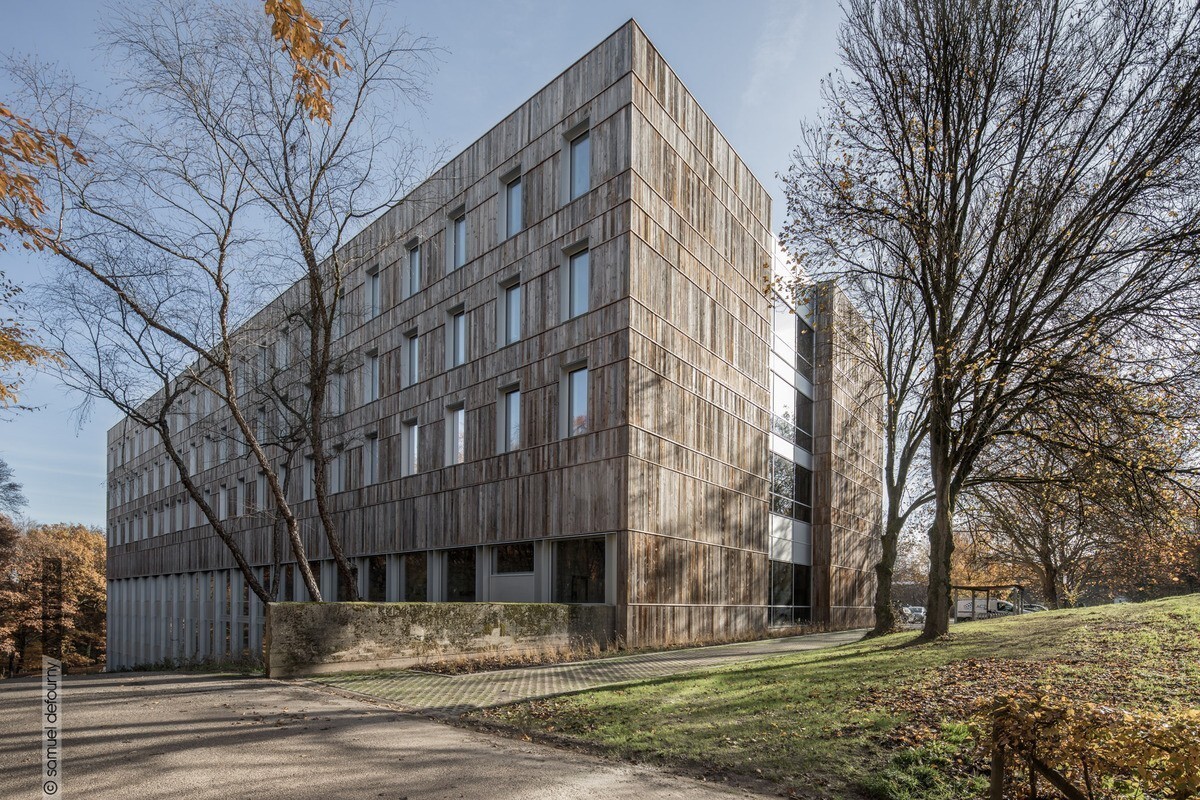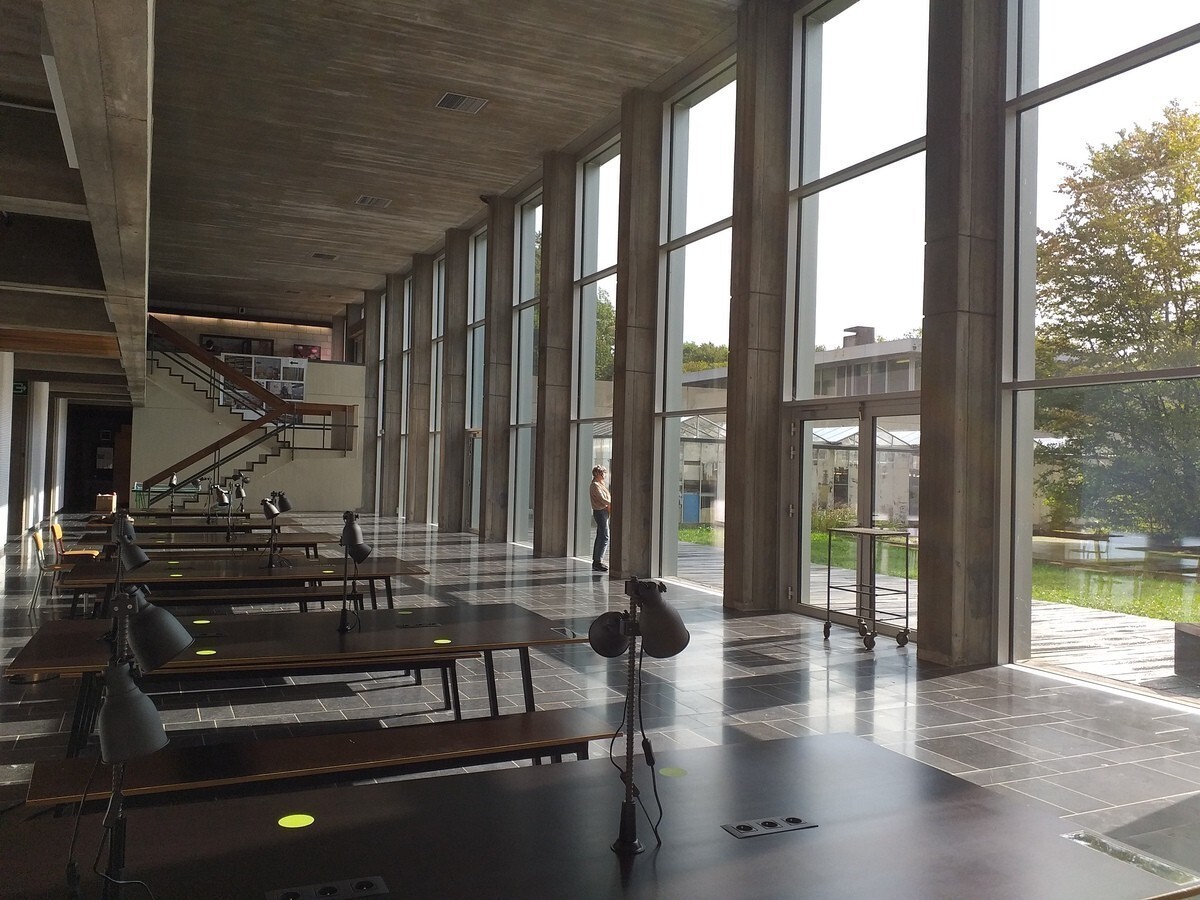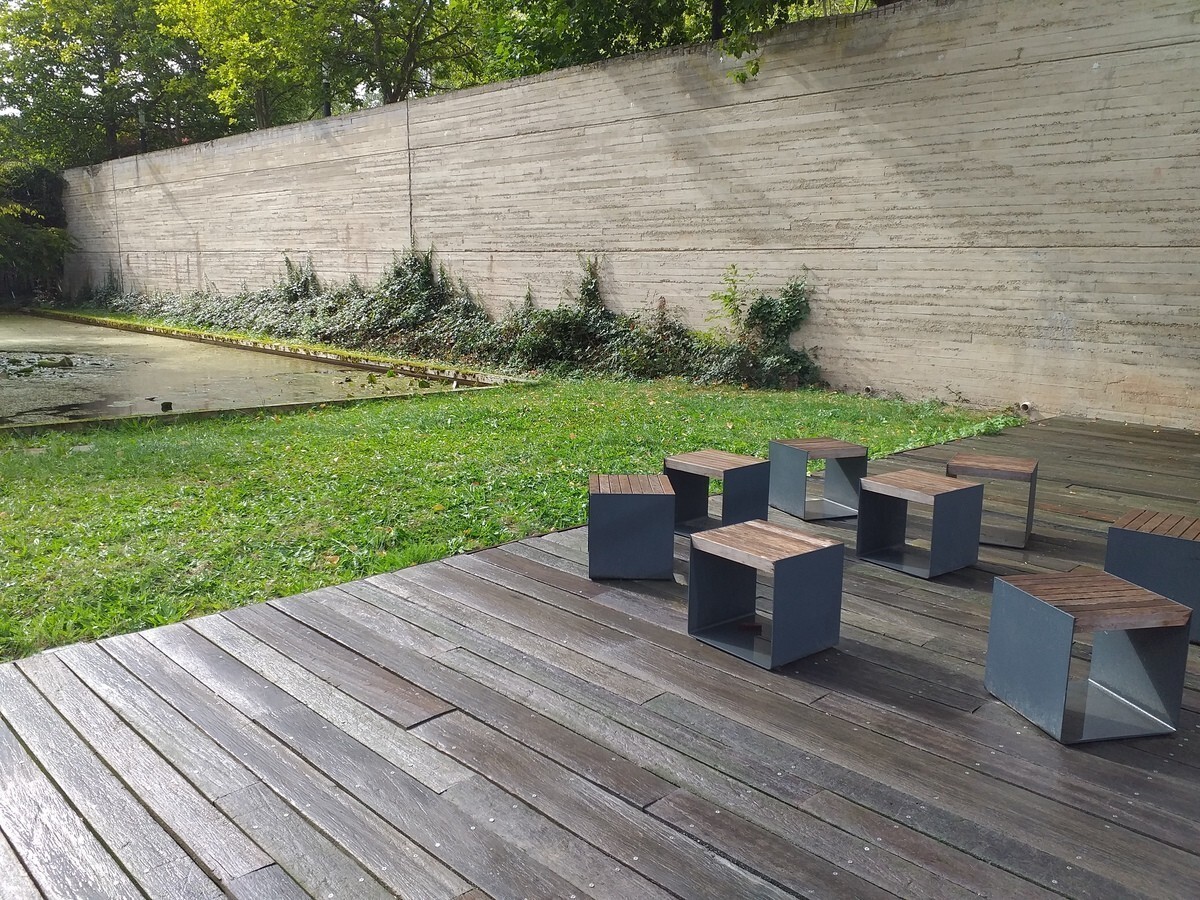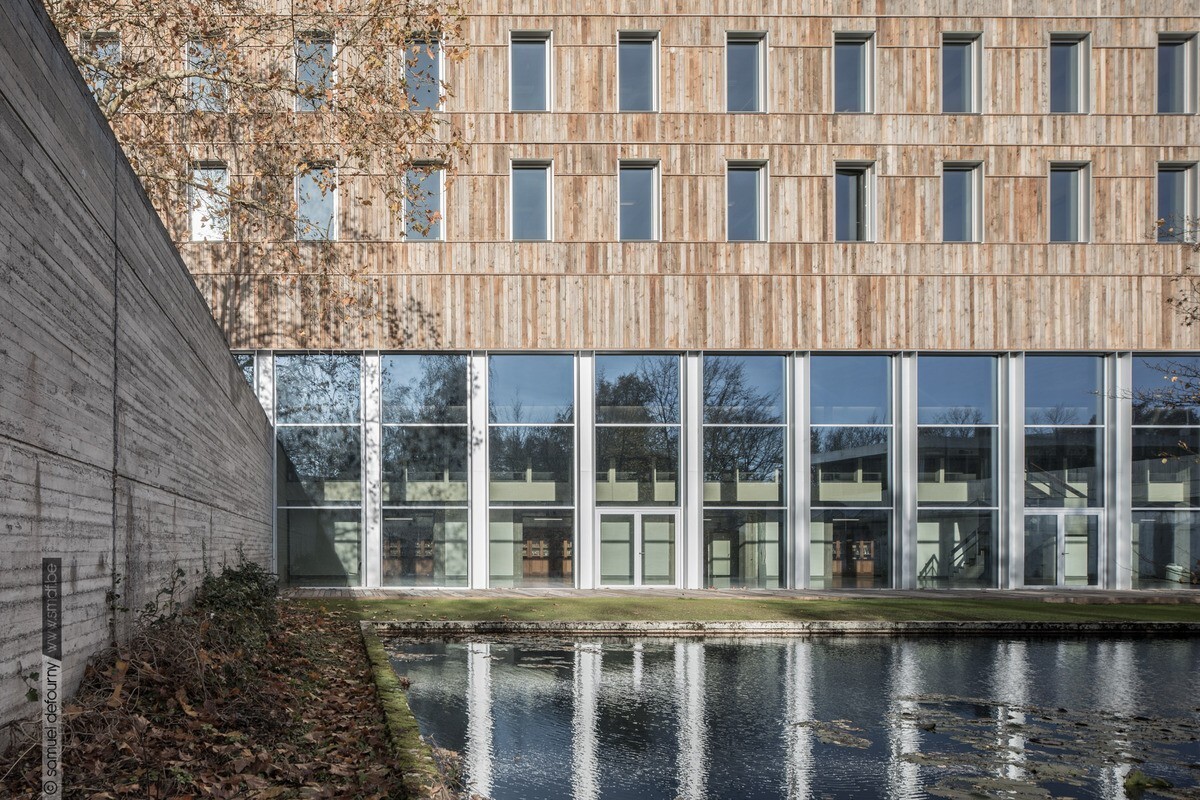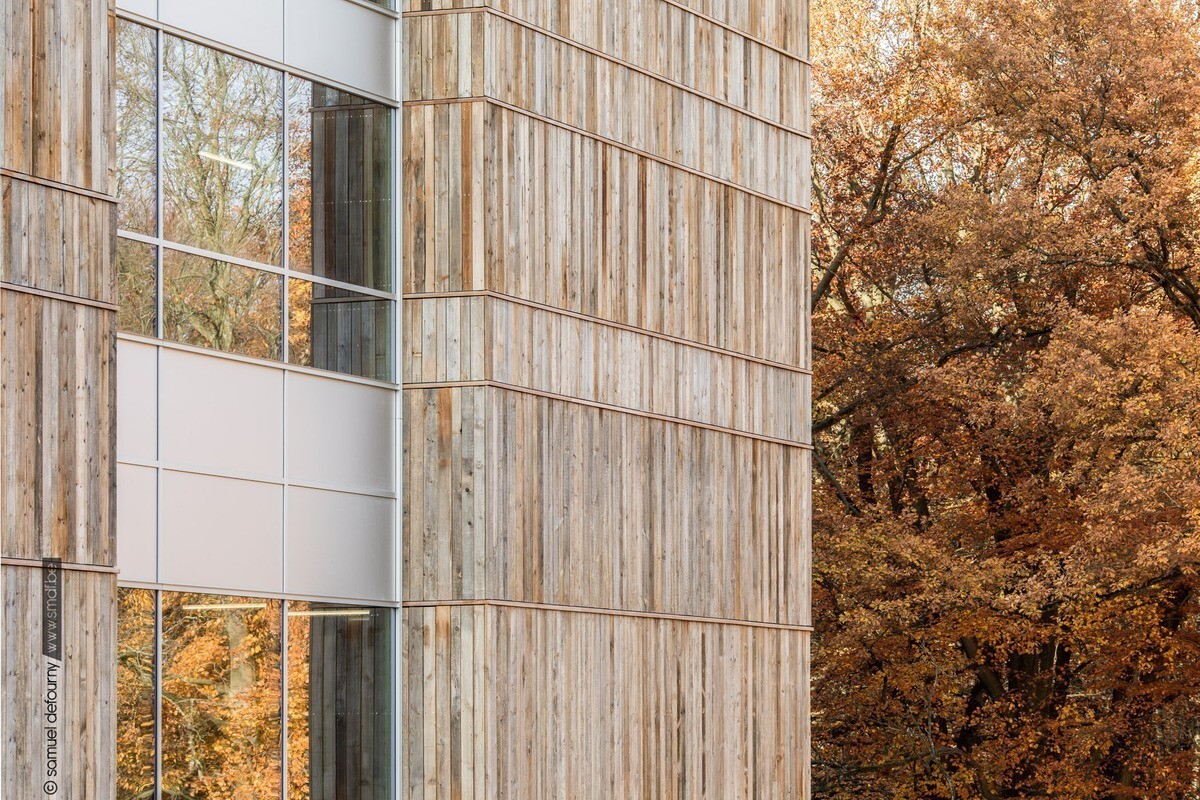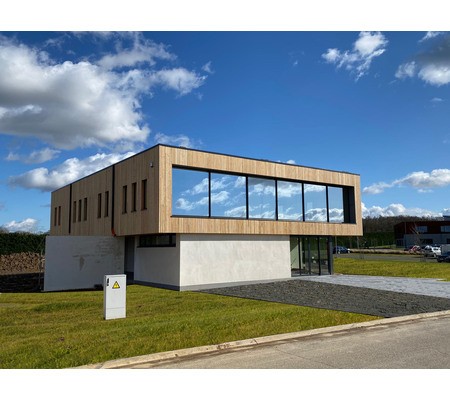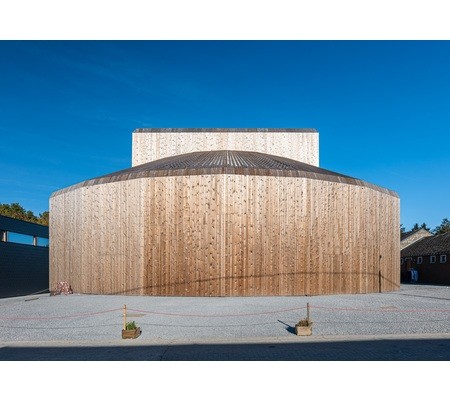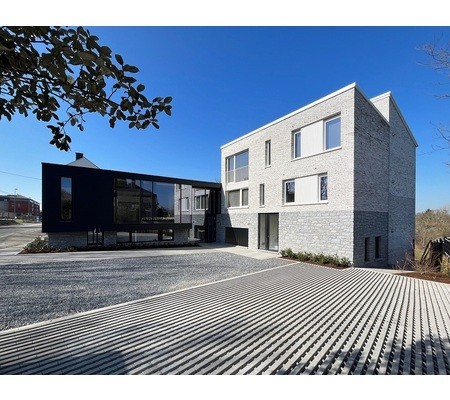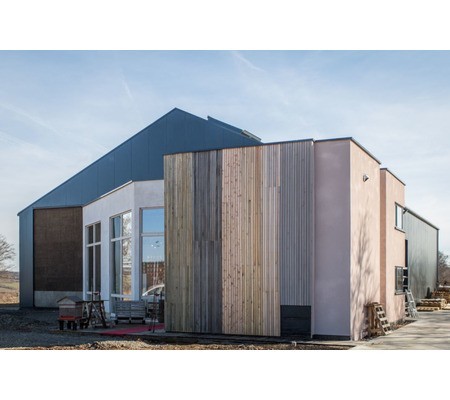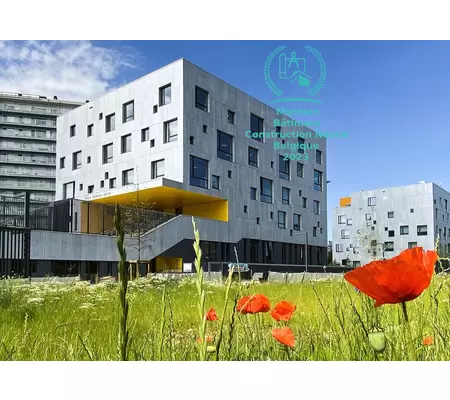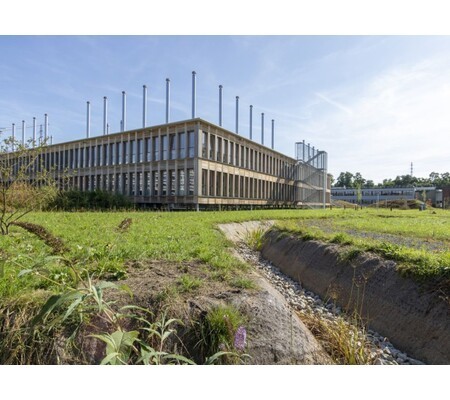Institute of Botany of ULiège (Building B22)
Last modified by the author on 17/01/2023 - 20:42
Heritage renovation
- Building Type : School, college, university
- Construction Year : 1968
- Delivery year : 2019
- Address 1 - street : Chemin de la Vallée, 4 4000 LIèGE, Belgique
- Climate zone : [Cfb] Marine Mild Winter, warm summer, no dry season.
- Net Floor Area : 9 000 m2
- Construction/refurbishment cost : 5 360 500 €
- Number of Pupil : 400 Pupil
- Cost/m2 : 595.61 €/m2
-
Primary energy need
357 kWhep/m2.an
(Calculation method : Other )
This project won a mention "Major project - adequacy between reuse and energy performance" for the Tertiary buildings category of the 2022 Circular Buildings Trophies.
The case study concerns the energy renovation of the Institute of Botany of ULiège (Building B22). This building was designed in 1968, according to plans by Roger Bastin. It is an important witness of modernist architecture in Belgium and is listed in the Inventory of Walloon Cultural Real Estate Heritage.
After 50 years of life without major renovation, this building has been the subject of an energy renovation project aimed at ensuring its durability for decades to come and at significantly reducing its energy consumption: -75% reduction in heating consumption and - 21% of electricity consumption (excluding scientific processes). A circular approach, particularly around the issue of reuse, is central to the entire project process. In addition to the installation of re-used wood cladding (2,600m²), various construction elements were dismantled, inventoried, cleaned and re-used in the renovation project.
This project is part of the sustainable development policy of the University of Liège. It was carried out between 2015 and 2019, as part of the eeef energy renovation program which enabled ULiège to finance studies aimed at renovating 8 of these buildings, all dating from the 1960s, as well as the public lighting network of the campus. The work, financed by the University's own funds, is now all finished.
Photos, project presentation document, summary of costs and energy savings: https://dox.uliege.be/index.php/s/tRriniDv3bGsDsF .
Circular economy and reuse of materials
Lots affected by the re-use / reuse of materials
- Blanket
- facades
- Outdoor Facilities
Materials, products and equipment reused or reused + quantity
- Installation of re-used wood cladding on the existing concrete facade (insulation with 30cm of mineral wool) > 2,600m² of cladding.
- Realization of the terrace in azobé planks coming from old docks of the Dutch ports, resold in Belgium > 140m².
- Recovery, restoration and reuse of 60/60 floor tiles for the project and on another university site > 120m².
- Recovery, restoration and reuse of metal roof cladding > 400 m².
- Rehabilitation of ventilation infrastructure > 50,000m3 of ductwork.
- Major renovation of an existing infrastructure rather than construction on a virgin site.
Origin, traceability of materials and field of use
- Siding - purchase via local supplier, materials from old farms in Eastern Europe.
- Azobé - purchase via local supplier, origin = Netherlands (short distances from the construction site).
- Floor tiles - materials recovered in situ.
- Metal cladding - materials recovered in situ.
- Sheathing - are part of the building.
Details of reusable materials
The use of reused materials external to the construction site:
- Barnwood type cladding from Eastern Europe, collected and distributed in Austria, resold in Belgium (Biemar Bois), implemented by the company Moury (subcontractor GROVEN Portal) for the construction of new facade cladding ( 2,600 m² );
- Azobé planks from former Dutch port docks, resold in Belgium (Biemar wood) for the construction of an outdoor terrace ( 140m² );
The reuse of materials from in situ deconstruction:
- Metal roof cladding ( 400 m² );
- 60/60 concrete slabs in floor layout ( 120 m² );
Rehabilitation of existing infrastructure:
- Recommissioning of an old ventilation unit shut down 20 years earlier: 50,000 m³ ventilation network restored from the old sheathings.
Reversibility / adaptability
The method of laying the reused wood cladding favored assemblies (no gluing) in order to facilitate subsequent maintenance, but also to allow reversibility of the intervention at the end of its lifespan.
In such a project, it is a question of starting from the material to go towards the development of an architectural proposal – and not the reverse. It is the material that dictates the composition: the lack of mastery of the material (different widths and thicknesses, varied renderings, etc.) means thinking about the project while guaranteeing flexibility of implementation at all times. This design process is not new. But, since the 19th century at least, this relationship has generally been reversed, favoring architectural design, to which matter must comply. Giving matter back its own logic of implementation also means giving it back its dignity. It is also a way of limiting the waste linked to the implementation. In the case of the Botanical Institute, the layout design complied with the specificities of the reuse boards, by following the following points:
- Siding installed vertically ensures that the material holds up well over time (faster rinsing of rainwater).
- The cladding interspersed with horizontal slats arranged at several spacings gives more regularity to the whole and avoids having to assemble heterogeneous boards end to end – which facilitates the work of implementation.
- By varying the dimension of the center distances, it was also possible to work with more heterogeneous elements, and in particular production offcuts, which were thus able to find a place in the composition.
- The horizontal lines that emerge from the composition also recall the traces of the formwork levels of the initial concrete.
Replicability and Innovation
The operation was designed specifically for the building to be renovated, with a view to respecting the heritage character and the original characteristics of the building. The initiative for re-employment procedures was carried out, from the outset, by the University of Liège, as Project Owner and Project Manager for this project, which is a facilitating element. The university's project managers then managed to convince the various project stakeholders (Authorities, financial services, companies, etc.).
The operation is presented on the OPALIS platform within the framework of the European FCRBE project in a desire to share experience and replicability, also to show the real, financial and operational feasibility of this type of approach.
The operation is replicable in itself (installation of a cladding of reused wood) but would lose in our sense of its interest in the heritage context which concerns us if it is reproduced
identically without attention to context. We did not choose reused wood only for the architectural and heritage part developed for this project. This choice of reuse was not arbitrary – do reuse for reuse. It was underpinned by a global architectural project which aimed to highlight the specific qualities of a material in the context of its use.
The reflections focused on different aspects:
- The texture : the texture of reused wood, strongly veined, is the inverse imprint of the texture of the original concrete. An analogy is created between the initial texture (still present inside the building) and the new facade cladding.
- Lack of control : at the time of construction of the building, the aesthetic quality of the concrete was relatively random (traces of poor workmanship, differences in color, etc.). This diversity, the result of on-site production, disappeared when the building was painted in the early 2000s; while it contributes, as much as the texture, to the brutalist character of the building. The reused wood thus makes it possible to reinject into the building a material of which the architect does not control all the aesthetic aspects.
- The age value (according to the Austrian art historian Alois Riegl): this 50-year-old building has a patina, the mark of the passage of time. The choice of a reusable material, itself patinated, furrowed, attacked… makes it possible to avoid the effect of a facelift and to preserve the building's dignity of its age.
- Sustainability : the objective is to complement energy sustainability (reduction of consumption and greenhouse gas emissions) with a deeper reflection on the durability of materials, with the intention of avoiding the overconsumption of resources and their looting.
The operations of inventorying, storage, cleaning and reuse, in the project or on site, of materials whose condition allows it is highly replicable, in particular within the framework of the buildings of the University of Liège, many of which date back from the 60s and 70s and have been designed in healthy, natural, quality materials, with a very good longevity. For example, the building's natural stone flooring is original and has not been modified due to its very good condition and very good resistance to time.
Storage of deposited materials and management of ex situ reuse
On-site storage of dismantled, cleaned and reused elements.
Constitution of a stock of slabs in the reserves of the university for use in other projects.
The scale of the project also made the continuous supply of materials on site more complex. No stock of 2,600m² being available as such on the re-employment market, it was necessary to sequence the supply in batches of +/- 400 m², with all the risks inherent in discontinuous arrivals. The schedule had to be revised several times. The intelligence of the company's site managers and the Contracting Authority was an asset because it made it possible to move from a linear schedule (phase after phase) to a horizontal schedule where several phases overlapped in order to guarantee , at any time, work for the teams and a construction deadline in accordance with the specifications. The budget was completed in compliance with contractual budgets and schedules.
Economic balance sheet
Total cost of reusing materials: €520,000
% reuse on total cost of the operation: 10%
Social and solidarity economy
The materials were purchased and implemented by a local company.
Our specifications for works contracts impose a limitation of subcontracting to two levels and the signing by companies of a charter against social dumping.
Subcontractors and suppliers are mostly local.
Building users opinion
User feedback is positive. Winter cold problems are solved. The heaters hardly work anymore and the comfort of the building is improved.
The construction phase had been more complex, because the building remained occupied during the works (research activities, teaching, material impossibility of emptying the building for 1.5 years), which involved a lot of nuisances (cold during the opening of facades, noise, dust).
If you had to do it again?
The project went very well overall, thanks in particular to the good collaboration of all the project stakeholders. If it were to be redone, two points would need to be improved: (1) finding buffer rooms in another building to spare the occupants during the work and (2) carrying out (which the program deadlines did not always allow) overall renovation/upgrading of the building (partial lighting, refreshment of interior finishes, etc.).
See more details about this project
https://opalis.eu/fr/projets/linstitut-de-botanique-de-lulghttps://dox.uliege.be/index.php/s/tRriniDv3bGsDsF
Data reliability
Self-declared
Photo credit
Samuel Defourny for photos B22 (1), B22 (2) and B22 (3); ULiège for others
Contractor
Construction Manager
Stakeholders
Construction company
Les Entreprises Gilles MOURY sa
Gwadamère GERARD GSM: 0491/71.27.67 ggerard[a]moury-construct.be
https://www.moury-construct.be/General construction company in charge of carrying out the works
Thermal consultancy agency
TEEN CONSULTING
Vincent KOWALCZYK
https://www.teenconsulting.be/Energetic audience
Contracting method
General Contractor
Energy consumption
- 357,00 kWhep/m2.an
- 107,00 kWhef/m2.an
Real final energy consumption
107,00 kWhef/m2.an
2 019
Envelope performance
Systems
- Combined Heat and Power
- Individual electric boiler
- No cooling system
- Nocturnal Over ventilation
- Double flow heat exchanger
- Solar photovoltaic
- Biomass boiler
Risks
Urban environment
Product
Reused wood (facade cladding)
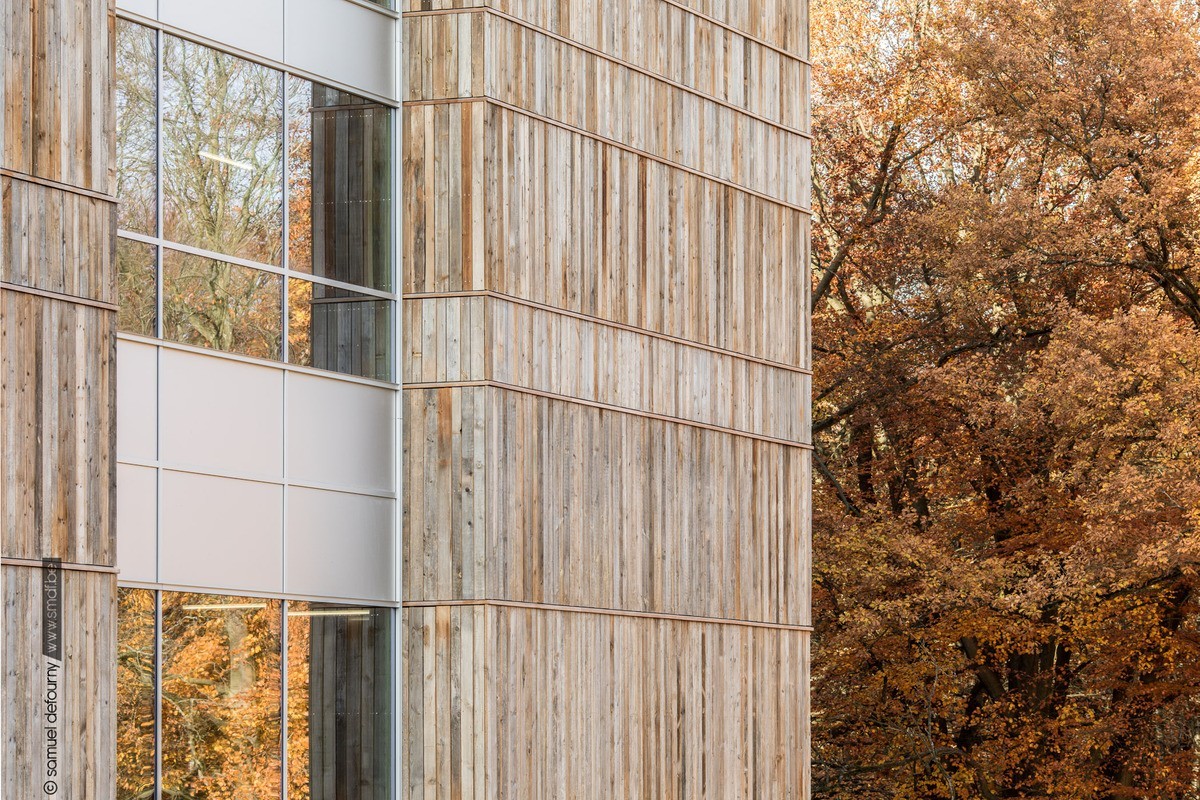
Gros œuvre / Structure, maçonnerie, façade
Reused wood cladding - planks from old barns in Eastern Europe.
This type of project, on a large scale moreover, leads to fears as to the durability of the materials, their reception by the users, the ten-year guarantees, the conditions (temporal and financial) of implementation... The company, for lack of knowledge of this subject and familiarity with reuse practices, initially showed a form of reluctance (without however directly opposing the proposal). Here again, it is up to the author of the project to provide the arguments as to the technical feasibility of the file and its aesthetic qualities. A sustained and in-depth study of the entire project upstream obviously puts the company in the best possible position. Most of the questions raised can thus be anticipated. The technical qualities of the managers and their experience are also crucial in the constructive dialogue that ensues.
60/60 floor tiles and metal roof cladding
Matériaux existants sur site
Second œuvre / Revêtements de sol
Very good acceptance of the solution.
AZOBE decking boards
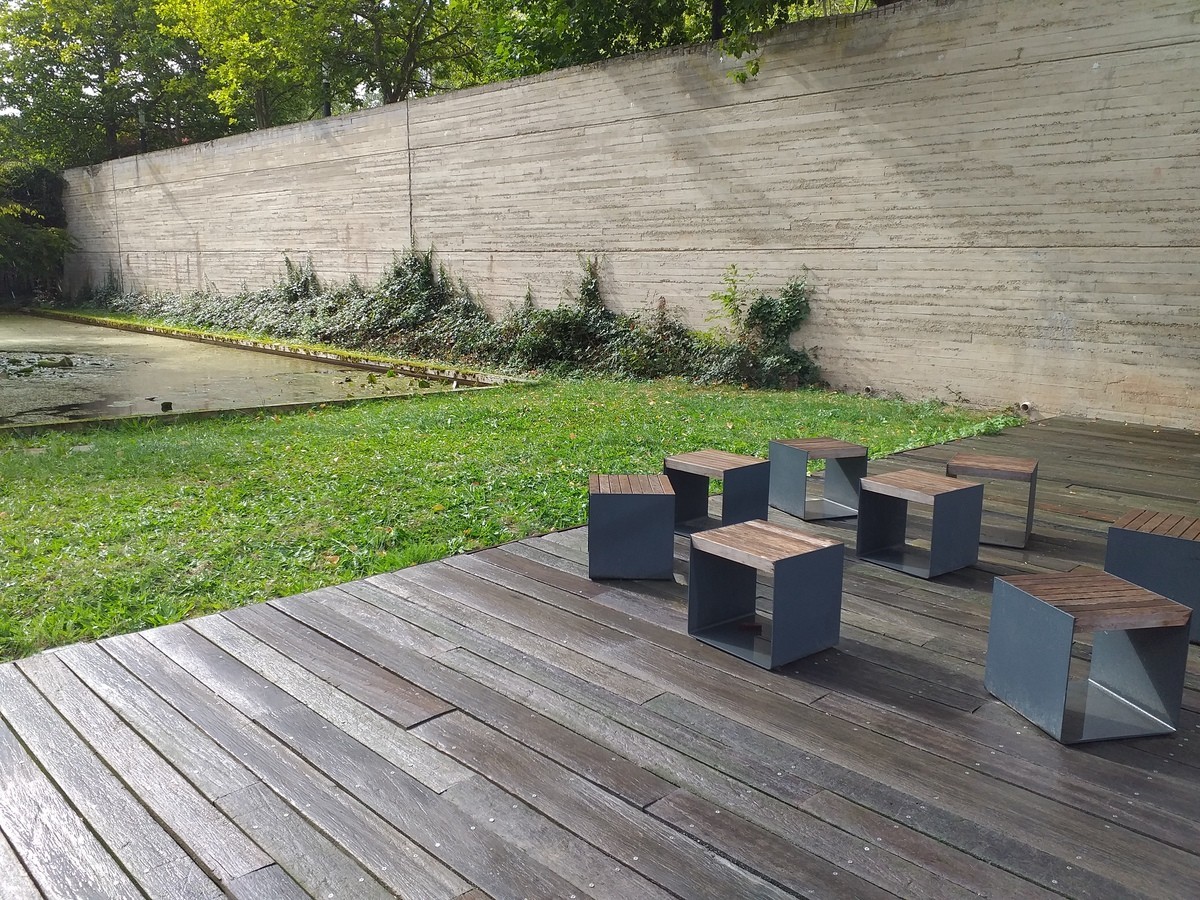
Realization of an outdoor terrace in reused azobe boards (former Dutch docks).
Very good, but substantial work to level the terrace (planks of different thicknesses) by the company.
Construction and exploitation costs
- 68 000,00 €
- 56 000 €
- 5 426 000 €
- 30 000 €
Reuse : same function or different function
- Roofing
- Facades
- Landscaping
Environmental assessment
| Categories | CO2 avoided (kg) | Water consumption avoided (m3) | Waste avoided (kg) | |||||
| Outdoor Facilities | 5973.738 | 26.710896 | 14827,17243 | |||||
| Landscaping / Locksmithing - Metalwork | 0 | 0 | 0 | |||||
| 0 | 0 | 0 | ||||||
| Partitions | 0 | 0 | 0 | |||||
| Blanket | 0 | 0 | 0 | |||||
| Roofing / Outdoor facilities | 0 | 0 | 0 | okay | ||||
| Lightings | 0 | 0 | 0 | |||||
| Security lights | 0 | 0 | 0 | |||||
| HVAC equipment | 0 | 0 | 0 | |||||
| Electrical equipment | 0 | 0 | 0 | |||||
| facades | 36766,34351 | 8847.744804 | 25467,16758 | |||||
| False ceilings | 0 | 0 | 0 | |||||
| Raised floors | 0 | 0 | 0 | |||||
| False ceilings | 0 | 0 | 0 | |||||
| Big work | 0 | 0 | 0 | |||||
| Sanitation facilities | 0 | 0 | 0 | |||||
| Insulation | 0 | 0 | 0 | |||||
| Exterior carpentry | 0 | 0 | 0 | |||||
| Interior joinery | 0 | 0 | 0 | |||||
| Furniture | 0 | 0 | 0 | |||||
| Painting | 0 | 0 | 0 | |||||
| Plumbing | 0 | 0 | 0 | |||||
| Floor coverings | 0 | 0 | ||||||
| Floor or wall coverings | 0 | 0 | 0 | |||||
| Wall coverings | 0 | 0 | 0 | |||||
| building security | 0 | 0 | 0 | |||||
| Locksmithing - metalwork | 714.070531 | 8.850474704 | 470.6229617 | |||||
| VRD | 0 | 0 | 0 | |||||
| CO2 avoided (kg) | Waste avoided (kg) | |||||||
| TOTAL | 43454.15204 | 8883.306175 | 40764.96297 | |||||
| km by small car | Number of rectangular bathtubs | number of years of household waste of a French person | ||||||
| Equivalent | 347633 | 59222 | 82 | |||||
| Equivalent trajet Paris- Nice | 395,0 | |||||||
|
The reuse operation saved the equivalent of 347,633 kilometers traveled by a small car, i.e. 395 Paris-Nice journeys, 59222 rectangular bathtubs filled with water and 82 years of household waste from a Frenchman |
||||||||
Economic assessment
- 520 000 €
- 10 %
Social economy
Reproductibility and Innovation
- The texture : the texture of reused wood, heavily veined, is the opposite imprint of the texture of the original concrete. An analogy is created between the initial texture (still present inside the building) and the new facade cladding.
- Lack of control : at the time of construction of the building, the aesthetic quality of the concrete was relatively random (traces of poor workmanship, differences in color, etc.). This diversity, the result of on-site production, disappeared when the building was painted in the early 2000s; while it contributes, as much as the texture, to the brutalist character of the building. The reused wood thus makes it possible to reinject into the building a material of which the architect does not control all the aesthetic aspects.
- The age value (according to the Austrian art historian Alois Riegl): this 50-year-old building has a patina, the mark of the passage of time. The choice of a reusable material, itself patinated, furrowed, attacked… makes it possible to avoid the effect of a facelift and to preserve the building's dignity of its age.
- Sustainability : the objective is to complement energy sustainability (reduction of consumption and greenhouse gas emissions) with a deeper reflection on the durability of materials, with the intention of avoiding the overconsumption of resources and their looting.
Indoor Air quality
Comfort
GHG emissions
- 39,00 KgCO2/m2/an
- 53,00 KgCO2 /m2
- 50,00 an(s)
Life Cycle Analysis
- reused wood cladding
- mineral wool
- reuse of original materials
Reasons for participating in the competition(s)
The energy renovation operation of the Botanical Institute seems to us to be exemplary for its integrated approach to sustainability and circularity at several levels:
- The renovation and reinvestment in the existing built stock, instead of new construction on a virgin site, is part of a strong approach to sustainable development and the reuse of existing infrastructure. The scientific literature has also highlighted the environmental benefit of major renovation compared to demolition/reconstruction operations.
- The project combines high energy and environmental performance with respect for the heritage character of the building, witness to the modernist architecture of the 1960s. of Liege.
- Energy performance (confirmed by measurement campaigns) has been greatly improved: -75% of heating consumption, -21% of electricity consumption (excluding scientific processes).
- Reuse and reuse have been at the heart of the approach since its conception (in particular life cycle analysis) which has made it possible to implement 2,600m² of reused wood cladding but also to restore and reuse, in situ or on other university sites, some original materials. The technical networks (ventilation) were also partially reused.
- The project is part of the broader framework of an energy renovation program for ULiège's infrastructures. On the strength of this experience, a second wave of energy renovation will begin (as part of the recovery plan of the Wallonia-Brussels Federation).
- The project materialized thanks to the integration, communication, collaboration and mobilization of all the players (architects, client, companies, user representatives).
- The work was carried out in an occupied building.
- Budgets and schedules were perfectly respected thanks to precise and rigorous technical and administrative management.
Building candidate in the category





